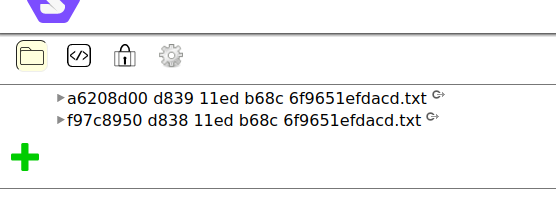So i changed and used the function you gave me.
When i click on the link where my file is supposed to be i’ve this :

The upload seems to work, but the name of the file isn’t the good one and the type of file too. I upload RDF file and got a TXT is that normal ?

Here is my full javaScript code :
import {
getSolidDataset,
getThing,
setThing,
getStringNoLocale,
setStringNoLocale,
saveSolidDatasetAt,
overwriteFile,
getSourceUrl,
saveFileInContainer
} from "@inrupt/solid-client";
import { Session } from "@inrupt/solid-client-authn-browser";
import { VCARD } from "@inrupt/vocab-common-rdf";
// If your Pod is *not* on `solidcommunity.net`, change this to your identity provider.
const SOLID_IDENTITY_PROVIDER = "https://solidcommunity.net";
document.getElementById(
"solid_identity_provider"
).innerHTML = `[<a target="_blank" href="${SOLID_IDENTITY_PROVIDER}">${SOLID_IDENTITY_PROVIDER}</a>]`;
const NOT_ENTERED_WEBID =
"...not logged in yet - but enter any WebID to read from its profile...";
const session = new Session();
const buttonLogin = document.getElementById("btnLogin");
const writeForm = document.getElementById("writeForm");
const readForm = document.getElementById("readForm");
const uploadForm = document.getElementById("uploadForm");
// 1a. Start Login Process. Call session.login() function.
async function login() {
if (!session.info.isLoggedIn) {
await session.login({
oidcIssuer: SOLID_IDENTITY_PROVIDER,
clientName: "Inrupt tutorial client app",
redirectUrl: window.location.href
});
}
}
// 1b. Login Redirect. Call session.handleIncomingRedirect() function.
// When redirected after login, finish the process by retrieving session information.
async function handleRedirectAfterLogin() {
await session.handleIncomingRedirect(window.location.href);
if (session.info.isLoggedIn) {
// Update the page with the status.
document.getElementById(
"labelStatus"
).innerHTML = `Your session is logged in with the WebID [<a target="_blank" href="${session.info.webId}">${session.info.webId}</a>].`;
document.getElementById("labelStatus").setAttribute("role", "alert");
document.getElementById("webID").value = session.info.webId;
}
}
// The example has the login redirect back to the index.html.
// This calls the function to process login information.
// If the function is called when not part of the login redirect, the function is a no-op.
handleRedirectAfterLogin();
// 2. Write to profile
async function writeProfile() {
const name = document.getElementById("input_name").value;
if (!session.info.isLoggedIn) {
// You must be authenticated to write.
document.getElementById(
"labelWriteStatus"
).textContent = `...you can't write [${name}] until you first login!`;
document.getElementById("labelWriteStatus").setAttribute("role", "alert");
return;
}
const webID = session.info.webId;
// The WebID can contain a hash fragment (e.g. `#me`) to refer to profile data
// in the profile dataset. If we strip the hash, we get the URL of the full
// dataset.
const profileDocumentUrl = new URL(webID);
profileDocumentUrl.hash = "";
// To write to a profile, you must be authenticated. That is the role of the fetch
// parameter in the following call.
let myProfileDataset = await getSolidDataset(profileDocumentUrl.href, {
fetch: session.fetch
});
// The profile data is a "Thing" in the profile dataset.
let profile = getThing(myProfileDataset, webID);
// Using the name provided in text field, update the name in your profile.
// VCARD.fn object is a convenience object that includes the identifier string "http://www.w3.org/2006/vcard/ns#fn".
// As an alternative, you can pass in the "http://www.w3.org/2006/vcard/ns#fn" string instead of VCARD.fn.
profile = setStringNoLocale(profile, VCARD.fn, name);
// Write back the profile to the dataset.
myProfileDataset = setThing(myProfileDataset, profile);
// Write back the dataset to your Pod.
await saveSolidDatasetAt(profileDocumentUrl.href, myProfileDataset, {
fetch: session.fetch
});
// Update the page with the retrieved values.
document.getElementById(
"labelWriteStatus"
).textContent = `Wrote [${name}] as name successfully!`;
document.getElementById("labelWriteStatus").setAttribute("role", "alert");
document.getElementById(
"labelFN"
).textContent = `...click the 'Read Profile' button to to see what the name might be now...?!`;
}
// 3. Read profile
async function readProfile() {
const webID = document.getElementById("webID").value;
if (webID === NOT_ENTERED_WEBID) {
document.getElementById(
"labelFN"
).textContent = `Login first, or enter a WebID (any WebID!) to read from its profile`;
return false;
}
try {
new URL(webID);
} catch (_) {
document.getElementById(
"labelFN"
).textContent = `Provided WebID [${webID}] is not a valid URL - please try again`;
return false;
}
const profileDocumentUrl = new URL(webID);
profileDocumentUrl.hash = "";
// Profile is public data; i.e., you do not need to be logged in to read the data.
// For illustrative purposes, shows both an authenticated and non-authenticated reads.
let myDataset;
try {
if (session.info.isLoggedIn) {
myDataset = await getSolidDataset(profileDocumentUrl.href, { fetch: session.fetch });
} else {
myDataset = await getSolidDataset(profileDocumentUrl.href);
}
} catch (error) {
document.getElementById(
"labelFN"
).textContent = `Entered value [${webID}] does not appear to be a WebID. Error: [${error}]`;
return false;
}
const profile = getThing(myDataset, webID);
const formattedName = getStringNoLocale(profile, VCARD.fn);
// Update the page with the retrieved values.
document.getElementById("labelFN").textContent = `[${formattedName}]`;
}
// 4. Upload file
async function uploadFile(event) {
event.preventDefault();
const fileInput = document.getElementById("fileInput");
const file = fileInput.files[0];
const url = `https://luciesorreau.solidcommunity.net/public/${file.name}`;
try {
const fileResponse = await saveFileInContainer("https://luciesorreau.solidcommunity.net/public/", file, { contentType: "text/plain" , fetch: session.fetch});
document.getElementById(
"labelUploadStatus"
).innerHTML = `File uploaded successfully at <a href="${url}" target="_blank">${url}</a>`;
document.getElementById("labelUploadStatus").setAttribute("role", "alert");
} catch (error) {
console.log(`Error uploading file: ${error}`);
document.getElementById(
"labelUploadStatus"
).innerHTML = `Error uploading file: ${error}`;
document.getElementById("labelUploadStatus").setAttribute("role", "alert");
}
}
buttonLogin.onclick = function () {
login();
};
writeForm.addEventListener("submit", (event) => {
event.preventDefault();
writeProfile();
});
readForm.addEventListener("submit", (event) => {
event.preventDefault();
readProfile();
});
uploadForm.addEventListener("submit", (event) => {
event.preventDefault();
uploadFile(event);
});


